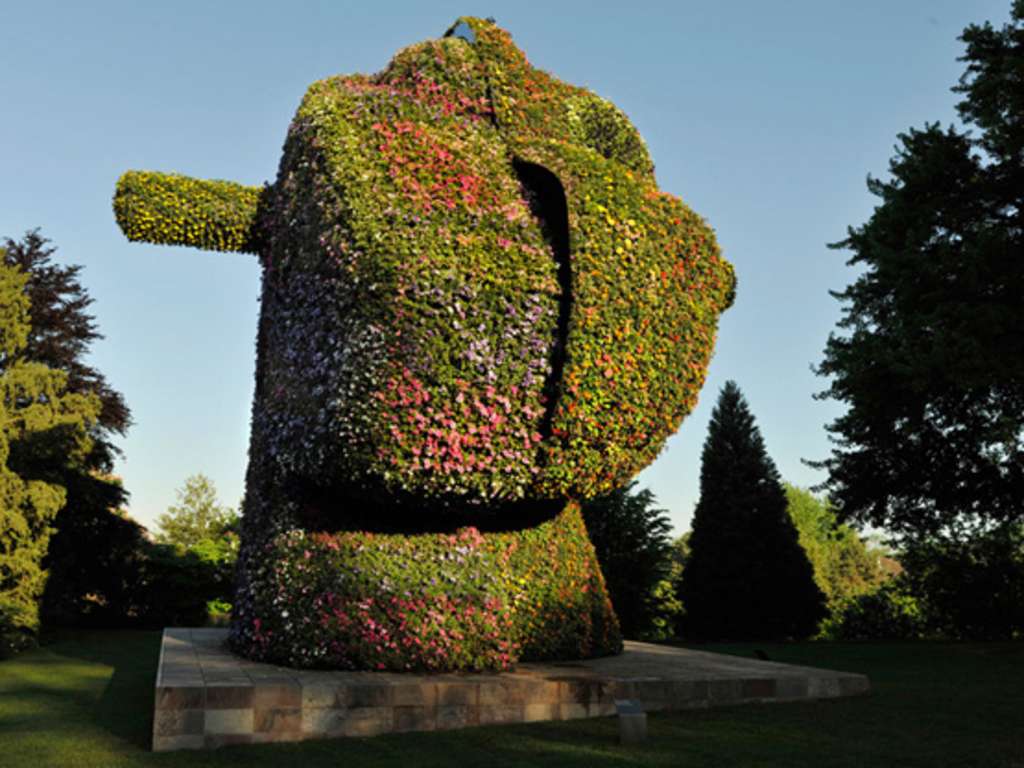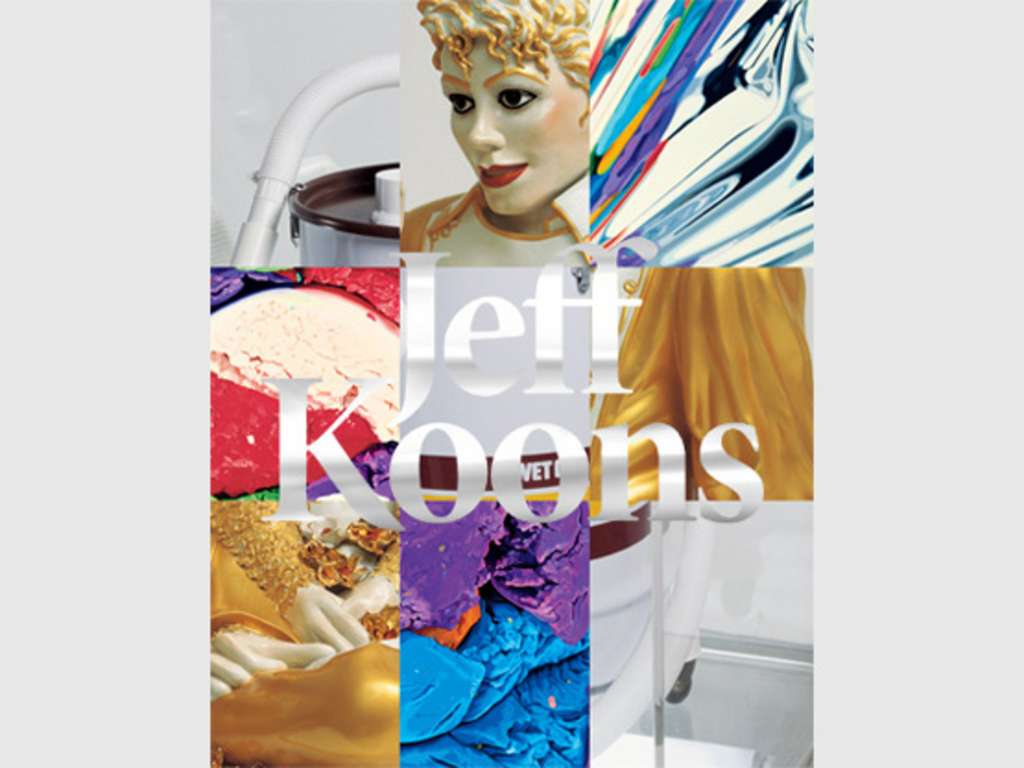May 13 – September 2, 2012
The Fondation Beyeler is presenting the first exhibition ever devoted by a Swiss museum to the American artist Jeff Koons (b. 1955). Koons, likely the best-known living artist, has for decades been causing a furore with the combination of popular and high culture that informs his art.
Our extensive presentation focuses on three central series of works – The New, Banality and Celebration – which represent crucial stages in Koons’s development and lead to the nucleus of his thinking and creative activity. The New comprises the ready-made-like cleaning appliances of his early period, symbols of newness and purity. Banality includes those traditionally crafted sculptures in porcelain and wood which have since become (post-)modern icons. Finally, in the Celebration series, on which Koons has been working for almost twenty years, appear high-gloss steel sculptures of unique material perfection, and large-format paintings in which the artist celebrates childhood in a veritably baroque way. Koons’s equally spectacular and subtle works are repeatedly concerned with themes such as innocence, beauty, sexuality and happiness. These reflect his conception of an art that is accessible to every viewer.
The New
From early on in his career, Jeff Koons has created his works in closed series to which he has given their own titles. The first series that he planned as such from the start is entitled The New. Koons conceived the works in this series between 1980 and 1982, although their production continued until 1987. The first room in the exhibition is entirely dedicated to this early series, which occupies a crucial place in Koons’s artistic development..
Banality
In 1988 Koons created his groundbreaking series entitled Banality, which was exhibited simultaneously in galleries in Cologne, New York and Chicago. In contrast to the series The New, in which he had still worked with minimalistically staged objects, he finally switched over to sculpture in Banality, while tending to orient his work more towards a Baroque popular aesthetic. With his much-remarked Banality series, Koons not only placed the concept of art on a new foundation but finally also became a star on the international art scene. As a series, Banality consists of twenty sculptural figures of which every last detail was conceived by the artist. In an edition consisting of three unique versions and an artist’s proof, Koons had his sculptures created by professional artisans who signed each work very visibly with their name, while his signature was placed beneath the sculpture. As a group, the Banality figures form an extensive panorama in which Koons’s artistic programme finds its expression: "In Banality, I was trying to tell people to have a sense of security in their own past, to embrace their own past. This was the most direct way that I started to speak about people not letting art be a segregator
Celebration
Originally conceived as a small project for a calendar, Celebration has since developed into Koons’s most elaborate series to date. From 1994 onwards, Koons was involved for many years in this massive project, which consists of monumental sculptures made of polyethylene or high chromium stainless steel as well as large-format oil paintings. The history of the creation of Celebration is closely tied up with events in Koons’s family life, particularly the birth of his son Ludwig Maximilian in 1992. In its character as a feast of the childlike, the Celebration series can also be seen as a token of the father’s love for the son who was taken away from him.
Jeff Koons at Fondation Beyeler. Introduction by Senior Curator Theodora Vischer.
Jeff Koons at Fondation Beyeler. Introduction by Curator Theodora Vischer and walk-through of the exhibition.
«Split-Rocker» - Interview with Jeff Koons
Interview with the American artist Jeff Koons on the occasion of his solo exhibition at Fondation Beyeler in Riehen, Switzerland. The exhibition runs until September 2, 2012. Jeff Koons talks about the idea behind Split-Rocker and what's special about the Split-Rocker in the park of the Fondation Beyeler.
Split-Rocker at the Fondation Beyeler from May until autumn 2012.
Split-Rocker, a colossal floral sculpture by the American artist Jeff Koons (b. 1955), comprising thousands and thousands of real plants, will be on view in the Fondation Beyeler park. The sculpture continues the compelling dialogue between art and nature that has become so characteristic of the Fondation Beyeler. Split-Rocker was first installed in 2000, in the cloister of the Palais des Papes in Avignon, then again a few years later in the gardens of Versailles (2008). Now Split- Rocker has begun to flourish in Riehen.
For his floral sculpture, Koons proceeded from two different rocker motifs, a pony and a dinosaur, whose heads he cut in half and then reassembled. Since the halves do not coincide, gaps are formed at certain places which open the sculpture out and transform it into an architecture that offers refuges. A disassembled and differently reassembled figure that simultaneously looks forward and to the side, Split-Rocker relates to the Cubism of Picasso while at the same time turning it in an entirely new direction. As a floral outdoor sculpture, the piece also continues the tradition of Baroque garden art and the topiary gardening still seen today in popular amusement parks.
With the combination of pony and dinosaur, Split-Rocker embodies that confrontation of opposites that is also expressed in the notion of a "monstrous" , gigantic children's toy. Yet the artist chooses transitory flowers, of all things, as the material for a monument that promises duration. It is not least in this special interplay of supposed opposites that the true tension and force of Koons's art lie.
The Split-Rocker project was made possible by the generous support of JTI.


Catalogue «Jeff Koons»
Three major groups of works by Jeff Koons exemplify his artistry
The inimitable works of art by Jeff Koons (*1955 in York, Pennsylvania), one of the most famous artists in the world today, have been causing uproars since the eighties. This publication is an in-depth examination of three major groups of works: The New (1980–87), Banality (1988), and Celebration (ongoing since 1994), each one of which represents a spectacular and consequential phase in Koons’s oeuvre. Ready-made objects from The New are transformed in Banality into wondrous, provocative sculptures created with traditional craftsmanship. A few years later, painting and sculpture appeared on an even par in Celebration. Hence, these three influential, manifesto-like stages are capable of providing insight into the work and ideas of Jeff Koons.
With a conversation between Jeff Koons and Theodora Vischer as well as essays by Raphaël Bouvier and Günther Vogt.
Edited by Fondation Beyeler, 2012, 212 pp., c. 80 ills., ca. 70 in color, 24.5 x 30.5 cm The cover was designed by Jeff Koons.

Biography
Jeff Koons (*1955, in Pennsylvania)